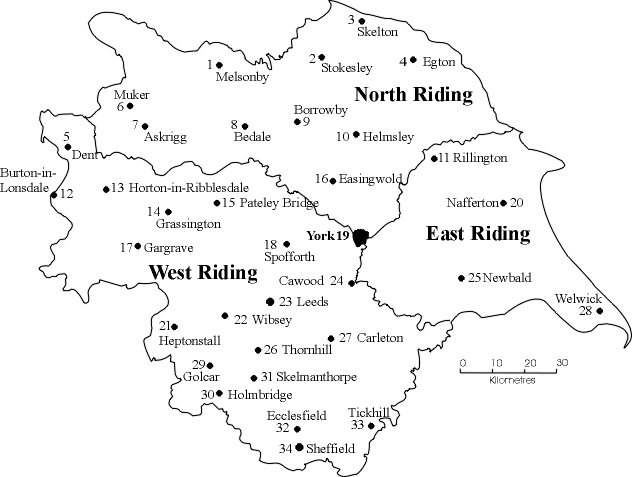


 |

|
 |
|
'Harold Orton often told us that it was the eleventh hour, that dialect was
rapidly disappearing, and that this [the Survey of English Dialects] was a last-minute
exercise to scoop out the last remaining vestige of dialect before it died out
under the pressures of modern movement and communication.' (Ellis, 1992: 7).
|
The following information regarding the SED is based on that provided by Harold Orton (1962) himself.
The notion of a survey of English dialects was first proposed in 1946 by Eugen Dieth, Professor of English Language at the University of Zürich, and Harold Orton of the Department of English Language and Medieval English Literature, University of Leeds. (The latter university's commitment to dialect research continues to this day within the School of English.) The underlying aim was to compile a linguistic atlas of England. The survey commenced in 1950 and spanned eleven years reaching its conclusion in 1961. The map below shows the selected survey sites in Yorkshire. The numbers therein signal the numerical order assigned to the individual locations. An old Yorkshire Evening Press article reporting the start of the SED may be viewed by clicking here.
 |
Copyright 1999: P. Morrison and B. Rawling, College of York St John, York
The following is a brief is a brief outline of the methodology employed:
Selection of Locations
The selection of the locations within Yorkshire, and those in other parts of the country, was based on a number of criteria:
However, no prior consideration was given to the to the social history of individual localities. Ultimately, the final selection was left to the individual fieldworkers themselves.
Selection of Informants
As with the selection of the survey sites, the choice of informants was the responsibility of the fieldworkers who, having conducted on-the-spot enquiries among the local populace, judged which individuals were the most suitable. Generally, two or three people were chosen from each community, selection being made with regard to the following criteria:
Methods of Elicitation
Information about the local dialect was obtained in three ways:
The Questionnaire
This consisted of in excess of 1000 items and was designed not only for the identification of lexicon, but also for the purposes of phonology, morphology and syntax.
Publication of the findings
The findings as they relate to Yorkshire were issued in 1962 in the first volume of the Basic Material (Eds: Orton and Halliday). Sixteen years later the original aim of the Survey was realized with the publication of the Linguistic Atlas of England. More recently, the excellent Dictionary and Grammar has been produced by Upton, Parry and Widdowson.
| Lexicon: an individual's knowledge of words which includes knowledge of: the word's pronunciation, its meaning or meanings, and the rules governing its usage within the grammatical system. |
| Phonology: the organization and description of the characteristic sounds of a language (including dialect). |
| Morphology: the study of morphemes and their different forms, and the way they combine to make different words. A morpheme is the smallest meaningful unit in a language which cannot be broken up without changing or destroying its meaning. For example: if <d> is removed from the morpheme mend it becomes men, a morpheme with a totally different meaning. |
|
Syntax: the study of how the formation of sentences is regulated and how words are integrated to form sentences. For example, the way words are ordered in a sentence can fundamentally alter the meaning of that sentence: John hit Tom. / Tom hit John. Mary is beautiful. / Is Mary beautiful? |
Sources
Ellis, S. (1992) 40 Years On: Is Dialect Dead? In Transactions of The Yorkshire Dialect Society, Vol. XVIII, Part XCII.
Orton, H. (1962) Survey of English Dialects : An Introduction, Leeds: E J Arnold and Son Ltd.
Orton, H. & Halliday, W. J. (eds) (1962) Survey of English Dialects: The Basic Material, Vol.1, Parts 1,2,&3, Leeds: E.J. Arnold & Son Ltd.
Orton, H. et al. (1978) The Linguistic Atlas of England, London: Croom Helm.
Upton, C., Parry, D. and Widdowson, J.D.A. (1994) Survey of English Dialects: The Dictionary and Grammar, London: Routledge.
Wakelin, M.F. (1994) Discovering English Dialects, Fourth Edition, Princes Risborough: Shire Publications Ltd.
Wardhaugh, R. (1992) An introduction to sociolinguistics, Second Edition, Oxford: Blackwell.